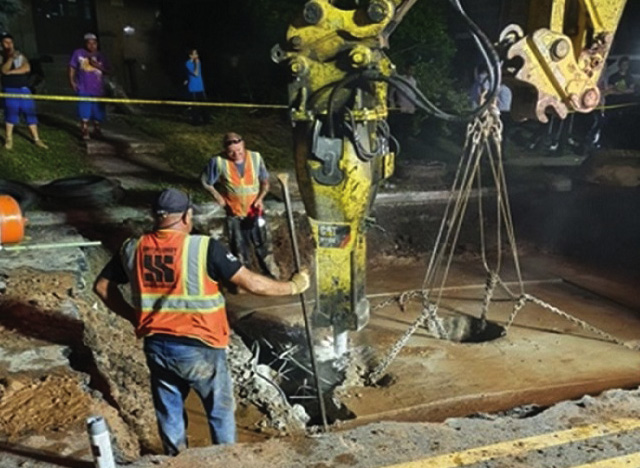
Passaic, New Jersey, is located approximately 11 miles west of New York City. Situated within Passaic County, the city has a population of 69,781 people occupying 3.2 square miles. Passaic is the 10th most densely populated municipality in the United States, with a population of more than 22,000 people per square mile. The Passaic Fire Department (PFD) operates four engine companies, two ladder companies, an Urban Area Securities Initiative foam tender, a quick-attack response vehicle, a utility pickup, a hazardous materials decon trailer, a fireground rehab unit, a reserve engine and ladder, and two rescue boats.
Incident Breakdown
Following is a breakdown of the swiftwater incident that occurred in Passaic on July 6, 2020.
Day 1. On Monday, July 6, 2020, at approximately 1600 hours, a severe thunderstorm brought torrential downpours of rain and hail to the area. In a little more than 90 minutes, nearly three inches of rain fell in the area, creating flash flooding conditions on roadways, underpasses, and streams.
RELATED FIREFIGHTER TRAINING
Swiftwater Rescue: Are We Ready?
HELICOPTER OPERATIONS IN SWIFTWATER RESCUES
SWIFTWATER RESCUE TACTICS, Part 1 | Part 2
At approximately 1706 hours, fire dispatch received a 911 call reporting a vehicle and its occupant being swept away by rising floodwaters at the intersection of High Street and Benson Court. Eyewitnesses reported the vehicle was attempting to drive through floodwaters when it was lifted away by the current and swept into nearby McDonald’s Brook, a tributary of the Passaic River. McDonald’s Brook is a natural stream originating in the bordering city of Clifton and passes through Passaic. For much of its length within Passaic, it runs through an underground culvert constructed by the United States Army Corps of Engineers in the 1930s. The brook runs alongside Benson Court before it enters an underground portion of the culvert under Main Avenue. From this point, the culvert travels under city streets and homes for approximately one mile until it deposits into the Passaic River, just east of Brook Avenue.
At 1707 hours, PFD’s Engine 1, Marine 1, and Battalion Chief 2 were dispatched to Main Avenue and Benson Court for the vehicle in the water. On their arrival at 1710 hours, numerous bystanders had gathered on scene and confirmed that the vehicle was sucked into the underground portion of the culvert. As heavy rain continued to fall, rising floodwaters were now up to the top of the underside of the culvert tunnel. PFD Battalion Chief Kevin Colavitti requested a SCUBA team from the neighboring town of Wallington. Marine 1 and Engine 1 were directed to conduct a visual search from the riverbank to locate the vehicle or any victims that may have washed up into the Passaic River. The swiftwater currents and rising water levels made it unlikely that any victims would be recovered alive.
While waiting for the dive team to arrive, bystanders advised Colavitti that the young woman driving the vehicle attempted to exit the car and was sucked into the underground culvert ahead of the car. At approximately 1715 hours, while formulating a plan to recover the vehicle’s operator, dispatch received a report from the Rutherford Police Department that a woman had been recovered alive on the Rutherford side of the Passaic River bank; the borough of Rutherford lies directly across the river from where the culvert exits.
After traveling nearly one mile underground in the swiftwater’s current, the victim, visibly shaken and in apparent shock, was able to pull herself out of the river; up the embankment; and to a nearby home, where she requested assistance. The woman was transported by Rutherford Emergency Medical Services (EMS) to a nearby hospital for medical treatment for minor injuries. It was later discovered that the 24-year-old woman was delivering food for Door Dash when the incident occurred.

(1) The Main Avenue/Benson Court opening, where the vehicle entered the drainage system. (Photo by Robert Policht.)
As a result of this incident, Marine 1 was redirected by command to the nearby Rutherford boat ramp to launch into the river. Backup boats from the Rutherford and Lyndhurst Fire Departments were also requested. Because of the high storm-related call volume, Marine 2 was unable to respond because it was helping rescue other motorists trapped in vehicles on flooded roadways. Marine 1 and mutual-aid boats searched for the vehicle and any other passengers who may have been swept through the canal and forced into the river.
By this point, the rain had stopped, and floodwaters began to recede. After several hours of searching for any additional parties, agencies decided to suspend all operations because of nightfall as well as the threat of more rain in the forecast. Concurrently, detectives with the Passaic Police Department (PPD) were dispatched to the hospital to perform a well-being check as well as obtain a statement from the victim. It was not confirmed until approximately 2130 hours that the female victim was the sole passenger in the vehicle.
After consulting with the captain of the Wallington SCUBA team, operations at the entrance of the canal on Benson Court proceeded only after floodwaters had dropped enough for team members to continue operating safely. The dive team donned its respective personal protective equipment and entered the underground canal to continue searching for the vehicle while tethered to safety ropes. Witnesses described the vehicle as a small four-door vehicle, possibly a Toyota. Not knowing the dimensions of the underground tunnel, it was assumed the vehicle would be wedged somewhere inside.
Dive team members entered the tunnel with combustible gas meters because of the possibility of combustible gases in the potentially oxygen-deficient environment. The team lost radio communications at approximately 450 feet in, and it was decided that they switch from Fire Channel 1 (a repeater frequency) to a direct fireground frequency. Unfortunately, this did not improve radio communications. At 2204 hours, all operations were ceased because of nightfall after it was confirmed there were no additional victims.
Day 2. On July 8, the weather forecast called for heavy rain, and flash flood warnings were in effect for July 10 around the New York metropolitan area. The Passaic Office of Emergency Management (OEM), PFD administrative staff, and the city engineer met to devise a plan to continue for the search and recovery of the lost vehicle. It was still undetermined if the vehicle had been swept through the culvert into the Passaic River or if it remained in the underground tunnel. With the threat of rain approaching, the issue was that, if the vehicle remained underground, it would create a dam-like situation. This could potentially cause further debilitating flooding for nearby residences and businesses.
City engineers worked with county engineering officials and the Passaic OEM to locate and review plans that detailed the culvert and underground portions of the tunnel. The plans included maps dating back to 1937. Initially, it was unsure if the tunnel followed the same course or if it had changed over the years because of the development of new neighborhoods. The tunnel reduces in size from an opening of 12 feet by 12 feet at the entrance to approximately 4 feet high by 6 feet wide at approximately 500 feet in. The map revealed that the tunnel made a right and then a left turn at two 45-degree angles in the vicinity of Stewart Street and Brook Avenue before straightening and traveling directly toward the river. It was thought that these bends would be the most logical locations to search for the vehicle. This key information set up the operation for the following day.
Day 3. On July 8 at 0930 hours, the PFD (under the command of Chief Patrick Trentacost), Battalion Chief Kevin Burgos, the Passaic OEM, and the Passaic County Sheriff’s Department SCUBA team responded to Main Avenue and Benson Court near the entrance of the tunnel. A unified command post was established, and a briefing was held with all members of the recovery operation. The Wallington SCUBA captain was also requested to the scene to brief the sheriff’s department on his findings from the day before. During the briefing, all parties involved discussed safety concerns and potential hazards they may encounter.
Because of the nature of the incident, an updated weather report for the area was obtained to monitor the potential of water rising in the culvert. As a safety precaution, Marine 1, Engine 1, and Ladder 2 were directed to the Passaic River to launch the boat prior to any personnel entering the culvert. This was done in the event of rainfall or if a diver was swept into the river by swift moving currents.
Divers entered the tunnel with personal flotation devices, helmets, hand lights, probing tools, and a multigas meter. They used a 900-foot guide rope to enter and proceed to the expanse of the first bend in the tunnel. However, because of limited radio communications and the exhaustion of the length of the guide rope, divers returned, leaving reflective markings on the walls as marker points while exiting the tunnel. After reviewing the tunnel’s blueprints, they determined this first bend to be under a home at the corner of Stewart Street and Brook Avenue. Divers then reentered the tunnel through a manhole near the intersection of Stewart Street and Brook Avenue to start the search anew.
Ladder 1 was dispatched to assist with the dive team’s efforts with ground ladders, lighting, and multigas meters. To improve radio communications, fire department personnel began to open and remove remaining manhole covers in the vicinity. At this time, command requested an urban search and rescue (USAR) company from the city of Paterson; this unit was called in for its technical confined space expertise and equipment. A fireground rehab unit was brought to the scene as temperatures were in excess of 90°F with high humidity, and heat stress was a concern for personnel operating in the tunnel in sealed dry suits.
Once the tunnel was deemed safe, the team was tethered to the rope and continued the search. The second bend in the tunnel was found, and members reported that the tunnel split once again; this smaller second tunnel was not on the map. Because of this, a decision was made to use environmentally safe dish detergent to determine where the split in the tunnel led. The detergent would act as an emulsifier, producing bubbles that would flow through the tunnel, thus providing clarity of its path. Accessible manhole covers were then opened to follow the path of the bubbles. The bubbles were found to expel into the Passaic River from a second smaller discharge tube approximately 25 feet from the main culvert.
Vehicle Recovery
At approximately 1300 hours, members opened a manhole in front of 41 Brook Avenue, 400 feet west of the river, and located the vehicle approximately 12 feet below the street. The vehicle’s dashboard was visible from the street, and it appeared that the vehicle had sustained heavy damage. Rescuers found what appeared to be human hair visible in the passenger compartment. The command post and rehab units were then relocated to Brook Avenue at the entrance of a nearby apartment complex. The PPD cordoned off the area and treated it as a possible crime scene. This incident had received much media coverage during the previous 36 hours, and a crowd of onlookers had gathered once again. The Paterson USAR Rescue Company used confined space camera equipment to perform an interior primary search of the vehicle when it was determined that the passenger compartment did not have any other passengers inside, and the hair found was from a wig.
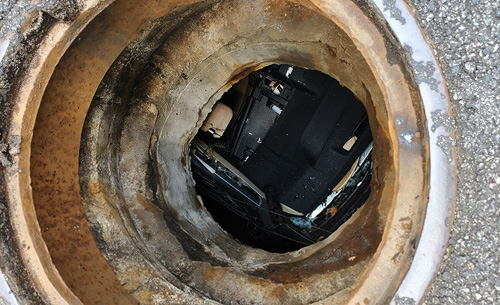
(2) The view of the vehicle as it was found by initial crews. (Photo by Robert Policht.)
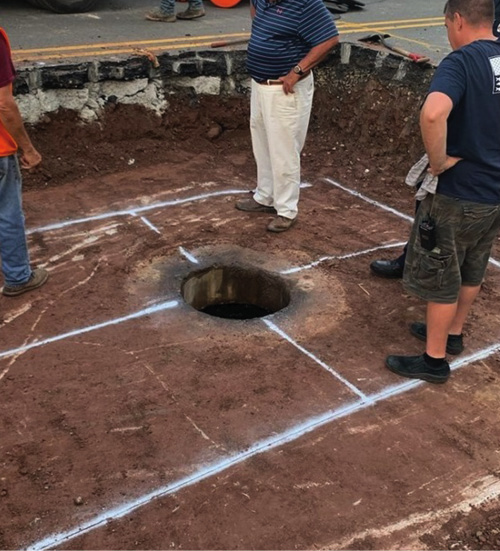
(3) Emergency construction crews developing their access operations. (Photo by Robert Policht.)
After further search, authorities also determined that the vehicle was wedged in the tunnel and lodged in place by a concrete column that was supporting the weight of the roadway. The vehicle’s hood had been completely crushed backward toward the passenger compartment and was wedged between the vehicle and the underside of the tunnel ceiling. The tunnel’s dimensions were found to be approximately four feet high × 10 feet wide at that point.
The Passaic Valley Water Commission, Passaic Department of Public Works (DPW) supervisors, and representatives from the county engineering department were summoned to the scene. Each entity concluded that the city of Passaic was responsible for the manholes in that location, and it would have to handle the vehicle’s removal. With heavy rain looming in the forecast, the Passaic OEM advised that the vehicle should be removed as soon as possible.

(4) Contractors were able to dig up the roadway and breach the tunnels in a controlled manner. (Photo by James Kovacs.)

(5) The vehicle lodged in the tunnel, prior to removal. (Photo by James Kovacs.)
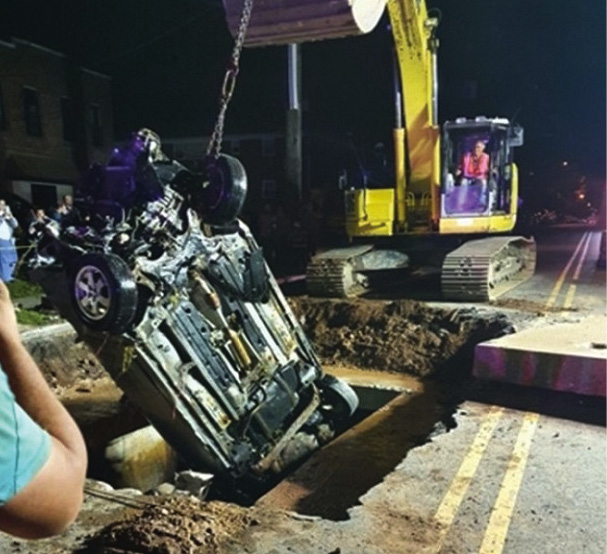
(6) The vehicle was removed by heavy machinery overnight while an engine company staged with a line. (Photo by James Kovacs.)
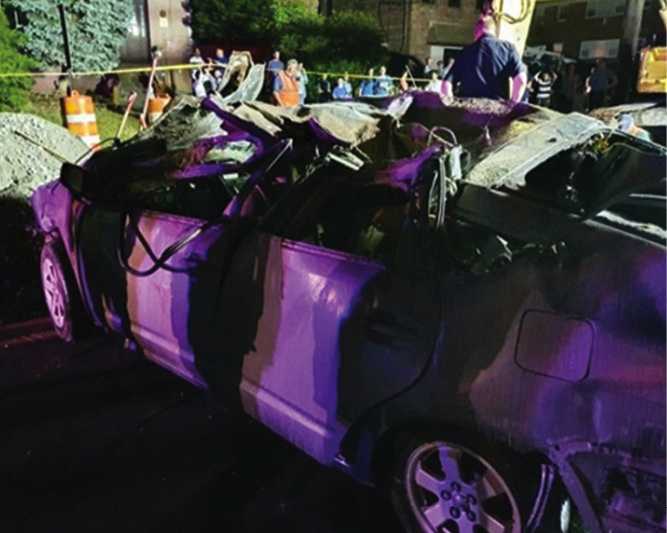
(7) The vehicle once it was removed from the tunnels. (Photo by James Kovacs.)
Smith-Sondy Construction of Wallington was notified to respond; within an hour, a supervisor was on scene to evaluate the situation. The local utility company, PSE&G, was notified and conducted an emergency mark-out of the street. At 1600 hours, a road crew from the construction company began working on the vehicle’s recovery. After about six hours of excavation, the roadway was opened, and the contractor had access to the tunnel. An excavator lifted the ceiling of the tunnel off the vehicle at approximately 2245 hours, nearly nine hours after the vehicle was initially found.
The 2020 Toyota Prius had sustained heavy damage. The roof was crumpled, all the windows had been blown out of the vehicle, and the front end and engine compartment were mangled. The hood was also folded back to the dashboard and creased in half. The vehicle was secured for removal with heavy tow chains while an engine company stood by on scene with a hoseline as a precaution against the ignition of combustible liquids from inside the vehicle.
An excavator lifted the vehicle out of the tunnel and then turned it over to a private tow company for removal from the scene. Fire department personnel searched the vehicle and the area of the tunnel thoroughly prior to leaving the scene. Brook Avenue remained closed for nearly two weeks after the incident as crews worked to rebuild the tunnel’s ceiling and repair the road surface.
Lessons Learned
Many lessons were learned as a result of this incident, with the following being the most significant:
- The fire department worked with the city and county engineers to locate and obtain updated maps of the culvert and underground tunnels. Previously, there had been no requirement for this information. Knowing this necessity and how the information was used, this intel was uploaded into the fire department’s emergency reporting system for future reference.
- Radio communications were an issue while operating within the underground portions of the culvert. At the onset, members used a primary repeater frequency but soon switched to a direct fireground frequency. Using a designated interagency tactical frequency was also discussed as a possibility to improve communications.
- Because of limited access into the culvert and underground tunnels, authorities recognized that they should call in a confined space rescue team immediately for any future incidents within the culvert for technical expertise and to use specialized equipment such as confined space cameras. Although this incident initially began as a swiftwater incident, the unit that responded was ill-equipped to handle a water recovery within a confined space.
- The safety of all first responders and contractors who entered the tunnel was paramount throughout the entire event. Monitor the air quality in the manholes and egress points with multigas meters for oxygen deficiency or other hazardous gases.
- Rehab units and EMS should be on scene whenever emergency personnel are operating in limited-access areas or while working for extended operational periods. Weather and temperature impacted operations throughout this incident. Incident commanders must rotate personnel frequently to prevent fatigue while keeping them hydrated. EMS personnel should also be on hand to monitor the vitals of all members operating in elevated temperatures or confined spaces.
- Because of the amount of time it took to access the tunnel and return to the point of entry as well as the likelihood for a swift current, all rescuers were tethered to a safety rope. To limit disorientation within the tunnel, deploy guidelines.
- Deploy additional marine units and SCUBA personnel as the rapid intervention crew to support units operating in the hot zone.
- The Department of Public Works and the local utility company were called during excavation. These local resources have additional expertise for working underground and in confined spaces that could have been valuable much sooner.
The events that unfolded on July 6, 2020, were nothing short of a miracle, but they also helped to raise awareness of the dangers that lurk below. This incident raised awareness for all first responders on the inherent dangers associated with swiftwater incidents within the culvert.
Take the time to think about and discuss what you think is not possible, and develop a game plan for it. It is not a matter of if but rather when something will happen. Expect the unexpected.
JAMES KOVACS is a 24-year fire service veteran who has served as a volunteer and career firefighter. He is the training and safety officer for the Passaic (NJ) Fire Department and a New Jersey-certified level II instructor, fire investigator, fire official, and emergency medical technician. Kovacs also served as the chief of the Garfield (NJ) Volunteer Fire Department in 2011. He has a bachelor’s degree in fire science from New Jersey City University.
ROBERT POLICHT is a member of the Passaic (NJ) Fire Department assigned to Ladder Company 1. He started his career as a volunteer and serves as the assistant chief and training officer of the Allendale (NJ) Fire Department. Policht is a New Jersey-certified firefighter II, fire officer II, swiftwater tech, and emergency medical technician. He has a master’s degree in emergency management and homeland security from Arizona State University. Policht is also a founder of and an instructor with Flow and Vent, LLC.

